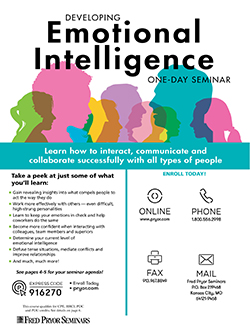How to Diffuse Difficult Situations
Effective communication is an essential skill for life and work – and diffusing difficult situations is an activity that we should all generally work to excel at. Difficult situations can happen for many different reasons:
- We disagree on how to approach a problem or event.
- We have different information about a situation, leading to different perceptions.
- We have different goals, values and criteria for success.
- There is a lack of role or process clarity – who is doing what when and how.
- External factors are creating constraints or pressures.
- We have a personality conflict – we just don’t see eye to eye.
- We have different priorities that are governing our time and choices.
- We don’t have enough time or money to do everything we want to do.
- Our different roles mean that we have different motives and serve different people.
- There has simply been a miscommunication or misunderstanding that needs to be resolved.
Understanding the reasons underlying the difficult situation can often give you a roadmap for diffusing the tension and preventing conflict.
Diffusing the Situation by Redefining the Problem
It can be useful to remember the expression, “success creates new problems.” When we achieve a success, like completing a project or launching a new product or service, it generally leads to a set of problems that are different from the problems we had before. These problems can lead to new difficult situations that need to be diffused. When we choose a path forward, we inevitably choose a set of problems that goes along with that path. This is life.
Seeing life as a constantly evolving set of problems can help reframe difficult situations from being a source of conflict to be a set of problems to solve. This makes them more actionable. Here are some examples of different types of problems – determining which ones apply to the situation can help you remove the emotion and focus in on next steps.
- Goal Alignment Problems – There is a lack of clarity about what the goal or mission is.
- Role Clarity Problems – There are disagreements about who oversees what or who should do what.
- Process Problems – We disagree on how to do something or what the workflow should be for a multi-step process.
- Technical Problems – Relates to the content of the situation. At work, this may be the technical difficulties of creating a new product or service. At home, this may be disagreeing on how to fix something.
- Conflicts in Time and Resources – There’s too much to do and too many places to be, or there are differences in how money should be spent or allocated.
- Political Problems – People in different power structures may be working at cross-purposes with project or technical staff.
- People Problems – Past hurts or missteps, or repeated or ongoing communication problems, lead to mistrust and an emotionally-driven inability to work through tough situations.
Of course, it is much easier to complete this problem analysis process when you can effectively navigate the emotional complexities of the situation! Pryor’s How to Manage Emotions in the Workplace is a great webinar for gaining the clarity and calm needed for effective communication. Confronting Workplace Conflict is another webinar that can help you both navigate and neutralize tox people and difficult situations.
A Communication Process for Diffusing Difficult Situations
Here is a proven process for diffusing tense discussions through communication. It only takes one person to start this process, and it does not need to be the person in charge. Often, people have more power than they think they do – so anyone engaged in the situation who is willing to exercise effective communication skills can help start the conversation and move the entire system.
- Bring together the right people – Think through who is involved in the current difficult situation and start conversations, either as a group or first through one-on-one or small group chats to explore the topic and get productive communication started.
- Name the tension – Often, just observing out loud that there is tension, and that the situation is difficult opens the door to talking about it. Pretending there is no problem often leads to escalation. In contrast, naming it diffuses it.
- Define the problem and the goal – Take some time to recalibrate about the problem and the goal. Using the list above see if you can describe the problem in those terms. Ask people to share what they believe the goal is and note agreement and differences – without judgement.
- Describe and analyze the current situation – Share the current facts and immediate needs or next steps as you each see them. What has each person seen, heard and experienced? Avoid blame and jumping to conclusions or solutions – right now, you are trying to non-judgmentally determine what is happening from different people’s perspectives.
- List options for action and decisions needed – Next, inventory the options for next steps, decisions to be made and who should make them based on what criteria. Make the decisions that you can based on what you have learned, but also stay open to not actually making all the decisions here. Instead, the main goal is creating a roadmap for the work ahead.
- Agree on action steps and check-in points – List specific steps different people agree to commit to and agree on when and how to regroup. Commit to open communication
It is not unusual for emotions to emerge and even run high in this type of engagement or interaction. Your goal is not to deny that emotion – it is to diffuse, focus and use it to help refocus the group. Pryor’s How to Handle Emotionally Charged Situations in the Workplace gives you tools you need to manage these confrontations and gain cooperation.
Core Communication Approaches to Diffuse Difficult Situations
Communication is an inevitable and ongoing process, and engaging in developing your communication skills will generally take you far. Here are some common characteristics of those who communicate well. Good communicators…
- Assume best intentions. It is easy to ascribe motives to others, or to assume others are behaving badly for a negative reason. Try to assume best intentions rather than assuming the worst – learn about the other person’s drivers and assumptions.
- Engage for the long-term. Often, communication is done to solve a here-and-now situation and problem. Effective communicators, though, communicate to build long-term relationships. Learning people helps you learn how to solve problems.
- Practice active listening. Listening is one of the hardest business skills to master because it means we need to take precious time to focus on another person and practice openness. Time is the biggest barrier to active listening. It takes time to really listen, process, test understanding and respond.
- Show curiosity and vulnerability. If you have a question or don’t understand something chances are others feel the same way. Effective communicators are not afraid to show the world their questions and uncertainty.
- Ask open-ended questions. Open-ended questions invite answers other than just Yes/No. Here are some examples: What are your thoughts about the goals/process/situation here? What do you think about ___? What other thoughts do you have about this? What else do you want to tell me? or just “Keep going – you are doing a good job processing (or explaining or working through) this.”
- Use the full body. Effective communication is an “all-in” experience. It involves putting down your phone, making appropriate eye contact, nodding and use both verbal responses and nonverbal actions to indicate you are listening. You can do this online as well as in person.
- Show care and concern. People will generally communicate more openly when they feel safe and cared for. Openly showing your care and interest in another person will go a long way in building support and trust – vital when diffusing emotions during difficult times.
Sometimes, we need to break bad communication habits as part of developing good ones. Pryor’s How to Avoid Bad Communication Habits seminar can help you refine your writing and verbal communication skills. In addition, some basic project management and leadership skills can help you identify the tension-causing elements of a situation and apply effective skills to break though! For these, check out Pryor’s libraries of Project Management Training and Leadership and Management Training.
Diffusing difficult situations is easier when there is a foundation of trust – and trust is only built over time. Introducing activities over time that build connections and relationships – through social hours, group trainings and events, awards events, one-on-one chats and effective performance and feedback conversations – are vital in providing a supportive environment for when things get tough. Building your individual communication skills can help you both navigate and lead at peak effectiveness.









